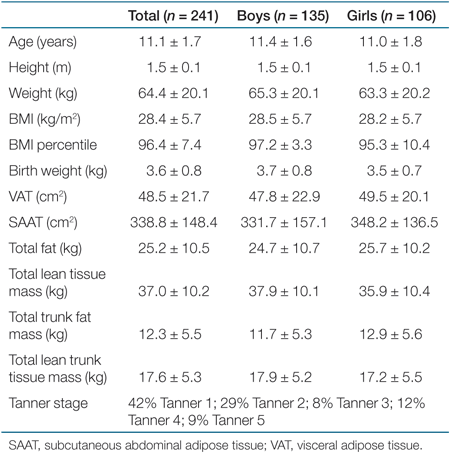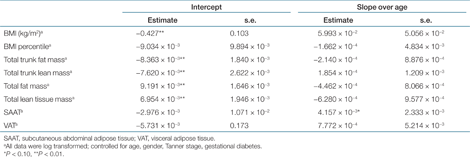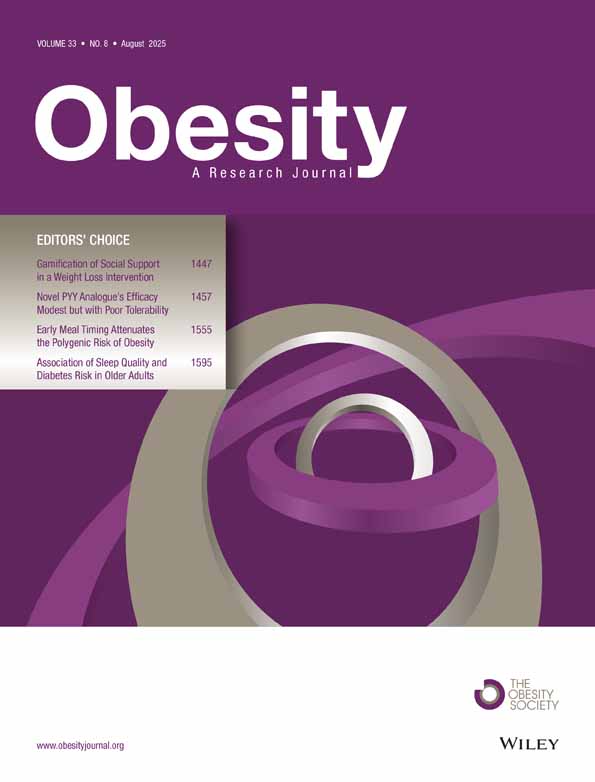Birth Weight and Body Composition in Overweight Latino Youth: A Longitudinal Analysis
Abstract
To examine the associations between birth weight and BMI, and total body composition, in overweight Latino adolescents. Two hundred and forty-two overweight Latino children (baseline age = 11.1 ± 1.7 years; BMI ≥ 85th percentile) were measured annually for up to 6 years (2.6 ± 1.4 observations/child, total 848 visits). Birth weight and history of gestational diabetes were obtained by parental interview. Visceral fat and subcutaneous abdominal fat were assessed by magnetic resonance imaging, while total body fat, total lean tissue mass (LTM), trunk fat, and lean tissue trunk mass were measured by dual-energy X-ray absorptiometry. BMI and BMI percentile were calculated using the Centers for Disease Control and Prevention age appropriate cutoffs. Longitudinal linear mixed effects (LME) modeling was used to evaluate the influence of birth weight on subsequent changes in body composition and distribution of fat across puberty. Birth weight significantly predicted BMI (P < 0.001), total trunk fat (P < 0.001), total trunk LTM (P < 0.001), total fat mass (FM) (P < 0.001), and total LTM (P < 0.001), but not subcutaneous (P = 0.534) or visceral fat (P = 0.593) at age 11 years. Longitudinally, as participants transitioned into puberty, birth weight did not significantly predict any of the body composition or fat distribution measures (P > 0.05). Birth weight is significantly associated with increased adiposity and LTM and negatively associated with trunk fat mass and trunk lean mass at baseline; however these relationships did not predict rate of change of any of the variables as the children progress through adolescence.
Introduction
Several studies over the past decade have examined the association between birth weight and relative weight in later life, particularly in light of increasing rates of obesity among children as well as adults in the United States (1,2,3). Prior cross-sectional studies have shown that birth weight is inversely associated with the risk of developing a number of disorders in later life such as type 2 diabetes (4), coronary heart disease (5), hypertension (6,7), and metabolic syndrome (8). Obesity and central adiposity distribution are known risk factors for the development of these disorders; therefore, the association of birth weight and these disorders may be driven by the relationship between birth weight and subsequent adiposity and fat distribution.
Birth weight represents a product of the in utero environment, which is considered a “critical period” for the development of obesity, type 2 diabetes, and cardiovascular disease later in life (9). Many investigators have described the development of chronic diseases in adulthood and how they have their origin early in life (10). However, to date, few reports have included analyses examining the relationship between birth weight and objective measures of body composition and body fat distribution during periods of growth and development. Previous studies assessing the relationship between birth weight and adult overweight, fat mass (FM), or body fat distribution have reported equivocal findings (8,11,12,13,14,15). Furthermore, most studies have included single measures of body fat or body fat distribution which may not accurately reflect the true relationships with these measures and birth weight.
The current study includes Latino children since they represent an understudied, high-risk population, and display marked obesity-related metabolic abnormalities. Furthermore, these boys and girls are potentially old enough for the effects of birth weight to influence body fatness. Characterizing these relationships in Latinos would be of clinical benefit from a health promotion/disease prevention standpoint. If such relationships are in operation in this population, one could easily justify obesity/type 2 diabetes prevention strategies in mothers to optimize maternal health to reduce prenatal complications and increase the likelihood of a healthy birth weight. With these points in mind, the aim of this study was to examine the relationships between birth weight and body composition cross-sectionally and longitudinally as overweight Latino children progress through adolescence.
Methods and Procedures
Study participants
Participants were recruited from the greater Los Angeles area to participate in the SOLAR (Study of Latino Adolescents at Risk) Diabetes Project at the University of Southern California. This study is an ongoing, longitudinal investigation exploring risk factors in a group of boys and girls at high risk for developing type 2 diabetes early in life. Data were analyzed from 242 overweight Latino children (136 males, 106 females) examined annually from 2000 until 2006. Study inclusion criteria were as follows: (i) aged 8–13 years; (ii) with a BMI ≥85th percentile for age and sex (Centers for Disease Control and Prevention, 2000) (16); (iii) of Latino ancestry (parents and grandparents descent as determined by self-report); (iv) absence of diabetes using established guidelines (17); (v) and have a positive family history of type 2 diabetes (determined by parental self-report). Approximately 70% of the SOLAR children were of Mexican descent with the remaining of Central American, or mixed Mexican-Central American heritage. Participants were excluded if they were taking medications known to affect body composition, diagnosed with any syndromes known to affect body composition or fat distribution, or had had any major illness since birth (e.g., maturity onset diabetes of the young, lipotropic diabetes or cancer). The study was conducted in accordance with the guidelines in the Helsinki Declaration. The Institutional Review Board of the University of Southern California approved this study. Written informed consent was obtained from both the parents and children before testing began. Findings from subsets of this cohort have been previously published (18,19,20,21), but no analysis of association of birth weight on adiposity parameters has been reported.
Birth weight data
At study entry, a detailed medical history was conducted, including parental interviews detailing birth weight of their offspring and presence/absence of gestational diabetes mellitus (GDM) which was based on parental self-report. One participant was recluded for the final analysis as their birth weight was >4 s.d. units from the mean. Birth weight was treated as a continuous variable and divided into one of the following four categories: <2,500 (n = 16), 2,500–2,999 (n = 27), 3,000–3,499 (n = 63), and >3,500 g (n = 135).
Anthropometric measures and tanner stage
Height was measured with a stadiometer to the nearest 0.1 cm. Body weight was measured without shoes and in a hospital gown to the nearest 0.05 kg using a beam medical scale. BMI was calculated; age- and sex-specific BMI percentile was determined using EpiInfo 2000, Version 1.1 (Centers for Disease Control and Prevention, Atlanta, GA). Pubertal status was determined by a physical examination conducted by a licensed pediatric health-care provider and was based on breast development in girls and pubic hair stage in boys using the criteria of Marshall and Tanner (22,23).
Body composition
A dual-energy X-ray absorptiometry (DXA) scan (Hologic QDR 4500W; Hologic, Bedford, MA) was performed to estimate total FM, and total lean tissue mass (LTM) (24). All scans were completed by technicians who were fully trained in the operation of the scanner, the positioning of participants, and analysis of results according to the manufacturer's guidelines.
Visceral (VAT) and subcutaneous (SAAT) abdominal fat distributions were measured directly by magnetic resonance imaging (MRI) at the University of Southern California Imaging Science Center. A single-slice axial TR 400/16 view of the abdomen at the level of the umbilicus was analyzed for cross-sectional area of visceral and subcutaneous adipose tissue. The scan lasted ∼5 min and a General Electric 1.5 Signa LX-Echospeed device with a 1.5-T magnet (GE Medical Systems, Waukesha, WI).
Statistical analysis
Data were tested for normality and transformations were made if applicable. The following dependent variables were not normally distributed and analyses were therefore run on the log-transformed value: BMI, BMI percentile, total FM, total trunk fat, total trunk lean tissue, total LTM, visceral and subcutaneous abdominal fat. χ2-Tests were used to assess differences in descriptive categorical data (e.g., gender, GDM) at baseline. Longitudinal linear mixed effects (LME) modeling was used to evaluate the effects of birth weight on longitudinal changes in BMI, BMI percentile, total trunk fat, total trunk lean tissue, total fat, total lean tissue, visceral (VAT) and subcutaneous abdominal fat (SAAT) variables across puberty. When using LME modeling, results include fixed effects (an intercept level of the dependent variable, a rate of change over age in the dependent variable), and random effects (a measure of variation around this rate of change with birth weight). The following covariates were entered into the models: gender, Tanner stage, and GDM. For all models, age of the child at each annual visit was used as the measurement of time. By modeling over age, we tested whether birth weight affected adiposity as children progressed from childhood to early adolescence. For all models, age was centered at mean baseline age (11.1 ± 1.7 years) for ease of interpretation of the intercept since a zero age intercept would not be meaningful. All analyses were performed using SPSS version 11.0, (SPSS, Chicago, IL) with significance set at P < 0.05.
Results
Baseline characteristics of participants
Characteristics of the cohort at baseline are shown in Table 1. The average age at baseline was 11.1 ± 1.7 years and our analysis included an average of 2.6 ± 1.4 annual visits per participant for a total of 848 visits. Twenty-three percent of mothers reported having GDM. At baseline, there were no significant gender differences in GDM, body composition, and fat distribution variables. However, girls were more physically mature (higher Tanner stage score) compared to boys (P < 0.01). At baseline 42 participants had a BMI percentile for age and gender between 85–95th and 200 participants had a BMI percentile >95th percentile.
 |
Birth weight and adiposity
Using longitudinal LME modeling over age with covariates (Tanner stage, gender, and GDM) at baseline age of 11 years, there was an inverse relationship between birth weight and BMI (β = −0.427, P < 0.001), total trunk fat (β = −8.363 × 10−3, P < 0.001), total trunk LTM (β = −7.620 × 10−3, P = 0.004), and positive relationship with total FM (β = 9.191 × 10−3, P < 0.001) and total LTM (β = 6.954 × 10−3, P < 0.001). However, at baseline age of 11 years, there was no relationship between birth weight and VAT (β = −5.731 × 10−3, P = 0.593) or SAAT (β = −2.976 × 10−3, P = 0.534). There was a positive relationship between birth weight and height and weight but these relationships were not significantly (r = 0.12, P = 0.06; r = 0.11, P = 0.06; respectively) at age 11 years. When β's were back transformed (for ease of interpretation) results showed that for every kilogram increase in birth weight, BMI was 0.65 higher at age 11, total trunk fat was 0.99 kg higher, total trunk lean tissue was 0.99 kg higher, total FM was 1.01 kg higher, total LTM was 1.01 kg higher, and SAAT was 1.00 kg higher.
Once the effects of birth weight on levels of body composition were controlled for, birth weight did not predict rate of change of any of the variables as children progressed through to early adolescence (Table 2). However, there was a trend for an association between birth weight and a change in SAAT across puberty (β = 4.157 × 10−3, P = 0.075). When the analyses included birth weight as categorical data (<2,500, 2,500–2,999, 3,000–3,499, and >3,500 g), the findings were also nonsignificant (all P > 0.2, data not shown).
 |
Discussion
In the present study, we investigated the relationship between birth weight and body composition using objective methodologies in a sample of overweight Latino children as they progressed through adolescence. We observed significant relationships between birth weight and body composition at baseline age of 11 years. Birth weight was associated with baseline BMI, trunk fat, trunk LTM, and with total fat and total LTM. After controlling for baseline levels, birth weight did not additionally modify the effect of increasing age on body composition. However, as participants progressed through adolescence, we found a positive trend for the association between birth weight and SAAT. To our knowledge, this is the first longitudinal study to examine the longitudinal relationship between birth weight and body composition as measured by DXA and MRI in an overweight Latino youth, particularly as they progress through adolescence. Identification of these prenatal risk factors for the development of childhood obesity, and determining the dynamic growth patterns associated with the onset of obesity, may help target prevention toward high-risk children.
The increase in BMI as participants’ progress through adolescence with increasing birth weight found in our study is similar to that found in other studies (25,26,27,28,29). Binkin et al., related birth weight to weight-for-height among 437,431 children from families from low socioeconomic backgrounds and found an association between a higher birth weight and increased risk of obesity (25). In another cross-sectional study, Seidmann et al. demonstrated a positive correlation between high birth weight and high BMI at 17 years of age (26). Rasmussen and Johansson (27) also found that high birth weights, coupled with either normal or high birth length-for-gestational age, were risk factors for overweight and severe overweight among young men in Sweden.
The reports which have failed to show a clear link between birth weight and adiposity in later life may have been limited by methodological issues. One study in a sample of 237 American children aged 7–12 years found no association between birth weight and subsequent adiposity as measured by skinfolds (28). Okosun et al. in a large ethnically diverse sample of 5–11 years olds found birth weight to be negatively associated with adiposity as measured by skinfolds (28). Although BMI is the standard indicator of weight status, it does not distinguish between LTM and FM, therefore many not be the most accurate measure of body composition, particularly in youth (29). Furthermore, the trend for a positive association between birth weight and BMI may be mediated by increases in either total or central adiposity. While the data on birth weight and adiposity are more consistent for adults than children, this may in part be due to the various anthropometric methods used such as waist circumferences and skinfold ratios which may be more subject to measurement error or intra- and/or inter-rater error. To our knowledge, there have only been a few other published studies in children and adolescents and most investigators have examined the effects of birth weight on child or adolescent adiposity using cross-sectional study designs. In the present study, we did not observe any significant longitudinal associations with birth weight and body composition or fat distribution as measured by DXA or visceral fat as measured by MRI.
The present study is unique in several aspects, thereby significantly expanding knowledge of the effects of birth weight on subsequent body composition and fat distribution. A special feature of the current study is that longitudinal mixed effects modeling was used to analyze the data, allowing us to examine the dynamic influence of birth weight on subsequent body composition and fat distribution during the adolescent period. Results were not based on one measurement time point, and therefore, may give more valid outcomes than results based on one single measurement. This study included over 200 Latino participants in a relatively narrow age range with over 800 hospital visits. Furthermore, body composition and fat distribution measure were collected using the objective techniques on DXA and MRI. To our knowledge, we are the first to use both objective techniques in Latino children as they transition from childhood to adolescence. Previous studies in children used various techniques, which made the interpretation of the results difficult.
Although we believe this study includes several inherent strengths, we acknowledge the limitations. The use of parental self-reports may be subject to recall error. However, studies show that compared to objective data obtained from medical records, offspring birth weight has been recalled by parents with a high degree of accuracy (30,31,32). Of course it maybe possible that any associations between birth weight and subsequent body composition might be mediated by more proximal factors in the prenatal such as birth weight for gestational age and postnatal environment, such as dietary intake and physical activity patterns. Children who are born small for their gestational age due to poor fetal nutrition may have a future propensity to obesity. The cumulative exposure time to a sedentary lifestyle and hypercaloric diets may have an impact on the future development of diseases such as cardiovascular disease and type 2 diabetes. As this data were not available for analysis, we can only postulate as to their contribution to future risk of obesity. However, it is possible that birth weight and a pattern of fat distribution may be genetically associated, as others have noted. Finally, the was restricted to overweight children (≥85th BMI percentile), while we regard the homogeneity of our sample as a strength, it should be noted that our findings may be specific to our unique study population and therefore may explain why our results differ from publications of positive associations between birth weight and body composition.
In conclusion, according to our longitudinal study, birth weight is significantly associated with increased adiposity at age 11 years as measured by BMI, DXA, and MRI. However, with the exception of BMI, our longitudinal data showed a lack of association between birth weight and change in adiposity as children progressed through adolescence. Identification of prenatal and early risk factors for childhood obesity, and determining the dynamic growth patterns associated with obesity, is one of the essential challenges for future research and may help target prevention strategies toward high-risk children.
Acknowledgment
This study was supported by the National Institutes of Health Grant R01 DK 59211, the General Clinic Research Center (GCRC) and the National Center for Research Resources Grant M01 RR 00043; and the American Diabetes Association, Mentor-Based Postdoctoral Fellowship 2005. We are grateful to the project managers, Christina Ayala, and Quintilia Avila and to the nurses and nutrition staff at the University of Southern California-GCRC. Finally, we express our gratitude to the children and their families for making this study possible.
Disclosure
The authors declared no conflict of interest.





